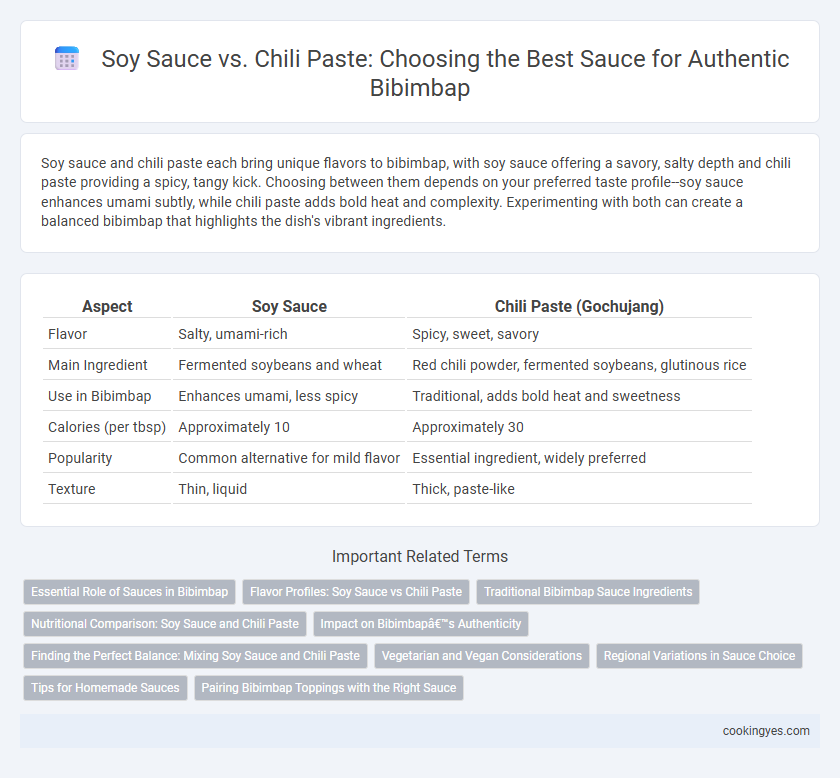Soy sauce and chili paste each bring unique flavors to bibimbap, with soy sauce offering a savory, salty depth and chili paste providing a spicy, tangy kick. Choosing between them depends on your preferred taste profile--soy sauce enhances umami subtly, while chili paste adds bold heat and complexity. Experimenting with both can create a balanced bibimbap that highlights the dish's vibrant ingredients.
Table of Comparison
| Aspect | Soy Sauce | Chili Paste (Gochujang) |
|---|---|---|
| Flavor | Salty, umami-rich | Spicy, sweet, savory |
| Main Ingredient | Fermented soybeans and wheat | Red chili powder, fermented soybeans, glutinous rice |
| Use in Bibimbap | Enhances umami, less spicy | Traditional, adds bold heat and sweetness |
| Calories (per tbsp) | Approximately 10 | Approximately 30 |
| Popularity | Common alternative for mild flavor | Essential ingredient, widely preferred |
| Texture | Thin, liquid | Thick, paste-like |
Essential Role of Sauces in Bibimbap
Soy sauce and chili paste (gochujang) each play an essential role in bibimbap, balancing umami and heat to enhance the dish's complex flavors. Gochujang provides a spicy, slightly sweet depth that defines the signature taste, while soy sauce adds savory saltiness that complements the fresh vegetables and rice. Together, these sauces create a harmonious flavor profile, making bibimbap a vibrant and satisfying Korean culinary experience.
Flavor Profiles: Soy Sauce vs Chili Paste
Soy sauce in bibimbap provides a savory, umami-rich depth with a subtle saltiness that enhances the natural flavors of vegetables and rice. In contrast, chili paste, specifically gochujang, delivers a bold, spicy sweetness combined with fermented complexity that intensifies the dish's heat and richness. The choice between soy sauce and chili paste fundamentally alters bibimbap's flavor profile, balancing between mild umami and vibrant spiciness.
Traditional Bibimbap Sauce Ingredients
Traditional bibimbap sauce primarily combines gochujang, a fermented chili paste rich in umami and fermented soybean flavors, with sesame oil, garlic, and sugar to balance heat and sweetness. Soy sauce, while used in some variations, offers a saltier and less spicy profile, complementing the dish with savory depth but lacking the distinct spicy kick of gochujang. Authentic bibimbap sauces emphasize the chili paste for its ability to unify the fresh vegetables, rice, and protein with a complex, vibrant flavor central to Korean cuisine.
Nutritional Comparison: Soy Sauce and Chili Paste
Soy sauce contains lower calories and sodium but offers essential amino acids and antioxidants, whereas chili paste is richer in vitamins A and C with capsaicin, which boosts metabolism and provides anti-inflammatory benefits. Both condiments contribute unique nutrients that enhance the health profile of Bibimbap, balancing flavor with nutritional value. Choosing between soy sauce and chili paste depends on dietary needs such as sodium intake restrictions or antioxidant supplementation.
Impact on Bibimbap’s Authenticity
Soy sauce offers a savory, umami flavor that enhances Bibimbap's traditional taste without overpowering its natural ingredients, preserving its authenticity rooted in Korean culinary heritage. Chili paste, specifically gochujang, is essential for maintaining Bibimbap's signature spicy and sweet profile, crucial to its authentic experience. Replacing gochujang with soy sauce alters the balance of flavors, potentially compromising the dish's cultural and sensory identity.
Finding the Perfect Balance: Mixing Soy Sauce and Chili Paste
Combining soy sauce and chili paste in bibimbap creates a harmonious balance of umami and heat that enhances the dish's vibrant flavors. Soy sauce adds a savory, salty depth that complements the spicy, slightly sweet punch of gochujang, the traditional Korean chili paste. Adjusting the ratio of these two condiments allows for a customized taste experience, achieving the perfect blend to match individual preferences.
Vegetarian and Vegan Considerations
Soy sauce often serves as a gluten-free, vegan-friendly condiment in Bibimbap, providing a salty umami flavor that complements vegetables and rice without animal products. Chili paste, such as gochujang, traditionally contains fermented soybeans but may include non-vegan ingredients like fish extract or honey, so checking labels is essential for strict vegetarian or vegan diets. Opting for vegan-certified gochujang ensures the spicy, sweet kick in Bibimbap aligns with plant-based dietary restrictions while enhancing overall flavor.
Regional Variations in Sauce Choice
Bibimbap's sauce choice varies significantly across Korean regions, with soy sauce favored in Jeolla province for its milder, savory profile, while Gyeongsang province typically prefers the bold, spicy flavor of gochujang (Korean chili paste). The Jeolla style emphasizes balance and subtlety, complementing fresh vegetables and rice, whereas Gyeongsang's preference for gochujang highlights intensified heat and fermentation notes that enhance the dish's complexity. These regional preferences reflect local palates and ingredient availability, shaping distinctive Bibimbap experiences nationwide.
Tips for Homemade Sauces
Homemade bibimbap sauces balance soy sauce's umami depth with chili paste's spicy sweetness for a customized flavor profile. Mixing gochujang with a dash of soy sauce, sesame oil, garlic, and sugar creates a harmonious sauce that enhances the dish's authentic taste. Adjust ratios based on preferred spice level and saltiness to perfect your bibimbap experience.
Pairing Bibimbap Toppings with the Right Sauce
Selecting the right sauce for bibimbap hinges on balancing the toppings: soy sauce complements lighter, savory ingredients such as sauteed mushrooms and spinach by enhancing their umami flavors without overpowering. Chili paste, or gochujang, pairs wonderfully with richer, spicier toppings like marinated beef and kimchi to add depth and heat. Matching the sauce to the topping profile intensifies the overall taste experience and maintains the harmony of this classic Korean dish.
Soy Sauce vs Chili Paste for Bibimbap Infographic

 cookingyes.com
cookingyes.com